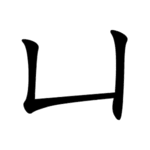Radical 17
Radical 17 is one of 23 of the 214 Kangxi radicals that are composed of 2 strokes.
| 凵 | ||
|---|---|---|
| ||
| 凵 (U+51F5) "receptacle" | ||
| Pinyin: | qiǎn | |
| Bopomofo: | ㄑㄧㄢˇ | |
| Wade–Giles: | ch'ien3 | |
| Cantonese Yale: | hom1 | |
| Jyutping: | ham3 | |
| Pe̍h-ōe-jī: | khám | |
| Kana: | うけばこ ukebako | |
| Kanji: | 凵繞 kannyō 受け箱 ukebako | |
| Hangul: | 입벌릴 ip beolril | |
| Sino-Korean: | 감 gam | |
| Stroke order animation | ||
 | ||
It does not occur as a character on its own. In combination, it historically takes meanings such as "open mouth", "box", "frame", "hole" or "receptacle". In contemporary use, it is the base radical of the following characters:
Also derived from the radical are the Simplified Chinese characters 击 "to hit" and 画 "to paint", without any historical connection to the radical.
幽 "deep, dark" is derived from radical 46, "mountain" 山 rather than radical 17.
As for the similar radicals 22 匚 and 13 冂, the name of radical 17 is purely descriptive of its shape, 下三框 "lower three-sided frame".
Characters with Radical 17
 Great seal script character
Great seal script character Small seal script character
Small seal script character
| strokes | character |
|---|---|
| without additional strokes | 凵 |
| 2 additional strokes | 凶 |
| 3 additional strokes | 凷 凸 凹 出 击 |
| 4 additional strokes | 凼 |
| 6 additional strokes | 函 |
| 7 additional strokes | 凾 |
| 10 additional strokes | 凿 |
Literature
- Fazzioli, Edoardo (1987). Chinese calligraphy : from pictograph to ideogram : the history of 214 essential Chinese/Japanese characters. calligraphy by Rebecca Hon Ko. New York: Abbeville Press. ISBN 0-89659-774-1.
- Leyi Li: “Tracing the Roots of Chinese Characters: 500 Cases”. Beijing 1993, ISBN 978-7-5619-0204-2
External links
This article is issued from Wikipedia. The text is licensed under Creative Commons - Attribution - Sharealike. Additional terms may apply for the media files.